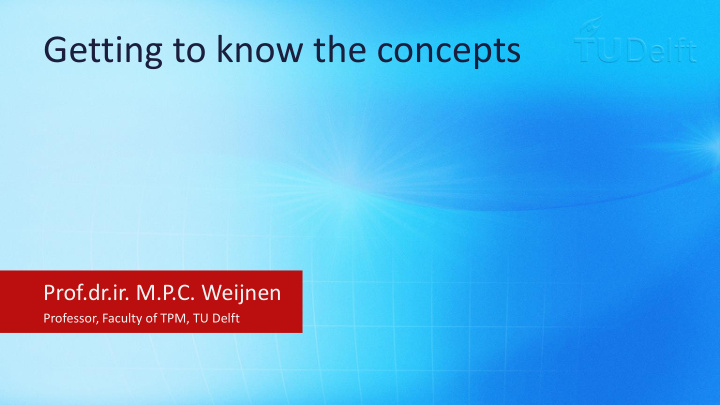



Getting to know the concepts Prof.dr.ir. M.P.C. Weijnen Professor, Faculty of TPM, TU Delft
Glossary Familiarize yourself with the basic concepts
Useful definition of infrastructure
Physical reality Megastructures of modern time Complex physical networks Engineering knowledge
Social reality Millions of interconnected users System of connected producers and consumers Physical and Social reality
Socio – technical systems & Physical dimension Social dimension
Importance of infrastructures Supply public services Examples: Energy Transport of People and Goods Information and Telecommunication Water supply Waste (water) removal
Importance of infrastructures Criteria for ‘good’ infrastructures: Availability Accessibility Affordability Acceptability
Value chain of electricity sector was: Generation Vertically integrated companies Transmission Often public or private monopolies Distribution Regulation to safeguard public values Supply
Value chain is changing Vertical unbundling New players enter the scene Competition in: Generation Supply Monopolistic system operators: TSO DSO
Natural monopoly Due to high capital costs infrastructure networks are often natural monopolies However , new technologies might change that E.g. Competing networks in ICT sector
Technological development Drives change in physical and social reality Impact of renewables: Scale of power generation
Technological development Drives change in physical and social reality Impact of renewables: Scale of power generation
Technological development Drives change in physical and social reality Impact of renewables: Scale of power generation Emergence of ‘ prosumers ’
Technological development New governance structures needed to ensure grid stability
Mismatch Mismatch between evolution of infrastructures and requirements Recall animation of evolution of the electricity infrastructure No master plan for integration Infrastructures are expected to function as integrated systems
The availability of infrastructures is not a given.
Infrastructure needs to be improved
Infrastructure failures Caused by, for example: Mundane causes like wear and tear A failure far away in the integrated infrastructure system A failure in another infrastructure on which it depends - Interdependencies
Next Generation Infrastructures During the course we will: “ Capture the socio-technical complexity using Complex “ Adaptive Systems theory
Dynamics in infrastructures Incentives Regulations Policy Regulators makers Power? Investors Operators Users Owners
Thank you for your attention! Please post any questions you may have on our discussion forum
References http://www.fotopedia.com/items/7mhe54ht6ccej-bHIuQy2LO5Q http://en.wikipedia.org/wiki/File:Ruta_Panamericana_Buenos_Aires_Florida.jpg http://upload.wikimedia.org/wikipedia/commons/d/d1/A_maglev_train_coming_out,_Pudong_Internat ional_Airport,_Shanghai.jpg http://www.flickr.com/photos/48722974@N07/4515205247/sizes/o/ The European electricity grid map was kindly provided by the European Network of Transmission System Operators for Electricity (ENTSO-E): https://www.entsoe.eu/ http://www.newscientist.com/gallery/mg20227061900-exploring-the-exploding-internet/2 Artwork on electricity network evolution by Mark van Huystee http://upload.wikimedia.org/wikipedia/commons/5/54/Sheringham_Shoal_Wind_Farm_2012.jpg http://upload.wikimedia.org/wikipedia/commons/4/45/Giant_photovoltaic_array.jpg http://upload.wikimedia.org/wikipedia/commons/e/e1/Solar_panels_on_a_roof.jpg http://upload.wikimedia.org/wikipedia/commons/f/f6/Well_of_Nivali.jpg http://www.youtube.com/watch?v=iEIk3RpV6RA
Recommend
More recommend